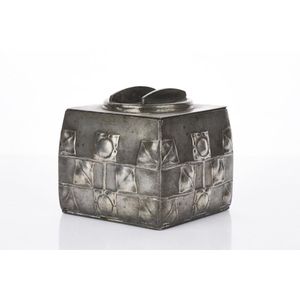
Knox for Liberty & Co. Tudric Pewter Biscuit Box
Archibald Knox (British, 1864-1933) for Liberty & Co., Tudric pewter biscuit box, c. 1901, of cubic form, moulded with high relief chequered stylised design, stamped and numbered to the underside, height 3.94 in. Provenance: Private Collection, Sydney

Tuderic Arts & Crafts Pewter Enamel Jewellery Box, c. 1900
Tuderic English Arts & Crafts pewter and enamel jewellery box, circa 1900, stamped 'Tuderic, 0906', 1.57 in. high, 3.15 in. wide, 2.36 in. deep

Art Nouveau Biscuit Box by Archibald Knox for Liberty
English pewter Archibald Knox for Libertys biscuit box detachable lid the body with stylised Art Nouveau motifs, shape number 0237 4.92 in. height

Archibald Knox Tudric Pewter Biscuit Box with Leaf Decoration
An Archibald Knox Liberty Tudric pewter biscuit box, stamped marks and # 0237, with stylised leaf and entwined tendril decoration. Twin bar form handles to the lid. 4.53 in. x 6.10 in. x 4.80 in.

Rainbow Enamelled Pewter Arts & Crafts Box
An Arts & Crafts rainbow enamelled pewter box, 1.97 in. high, 4.33 in. wide, 2.36 in. deep

Archibald Knox Tudric Pewter Biscuit Box
Early Tudric Pewter lidded Biscuit Box attributed to Archibald Knox, marked to base and # 0237, height 4.72 in. approx.

Hand-Beaten Brass and Copper Box with Semi-Precious Stone Inset
An Arts & Crafts Hand-Beaten brass and copper box, late 19th century, of rectangular form, the copper hinged top inset with a circular semi-precious stone to the centre, surrounded with an entwined, scrolling vine motif also appearing on the body, the whol

Tudric Enamel Landscape Pewter Box
An English Arts & Crafts pewter and enamel box, by Tudric, early 20th century, of rectangular form with moulded edges, the hinged top featuring a decorative painted landscape in enamel, and an oak-lined interior. Factory stamp to base with serial number '0

Archibald Knox Tudric Enamelled Biscuit Box
An English Pewter (Tudric) Archibald Knox design pewter and enamelled biscuit box, square form, decorated with the Honesty leaf motif with blue/green enamelled highlights, the fitted lid with traditional double bar handle. Stamped mark and design no. 0194,

Archibald Knox Pewter Biscuit Box with Ivy Design
An Archibald Knox designed 'English Pewter' biscuit box, decorated with stylised ivy, square form with conforming lid with a circular panel and two raised bars, impressed marks, shape #0194. 4.92 in. x 4.92 in. x 4.33 in.

Tudric Liberty Pewter Dressing Table Box with Pearl Finial
Vintage Tudric Liberty pewter dressing table box inset pearl finial to lid, lobe shaped base, marked to base and # 0902, height 1.97 in.

Tudric Pewter Enamel Sunset Landscape Box
A Tudric pewter and enamel square box, the lid with a raised pictorial panel of a sunset landscape, the interior with original green velvet and satin lining, with Liberty & Co. Regent Street, London printed in gilt to the lining of lid impressed maker's ma

Archibald Knox Enamel Pewter Biscuit Box
Archibald Knox for Liberty & Co pewter & enamel biscuit box square shaped with detachable 2 handled lid, stylised spade shaped motifs to each side including 2 enamel examples, stamped English pewter, model no 0237.

Archibald Knox Honesty Pewter Biscuit Box
An Archibald Knox design pewter biscuit box, traditional square form with 'Honesty' decoration, the lid with a circular panel and two raised ridges, most old varnished finish remains. The base marked 'J.B 2765'. 4.72 in. x 4.72 in. x 4.53 in.

Enamelled Arts & Crafts Copper Box
A good Arts & Crafts copper, brass and enamelled box, the rectangular lid with a pierced motif of a tree branch backed by a polychrome enamelled panel outlined by embossed slender whiplash stems. Riveted brass clashed edging and four splayed feet. The inte

Archibald Knox 'Honesty' Pewter Biscuit Box
An Archibald Knox 'Tudric' pewter biscuit box, traditional decoration with 'Honesty' decoration with enamelled highlights, some missing, square form, the conforming lid with a circular panel and two raised ridges, impressed marks including shape #0194. 12.

Archibald Knox Biscuit Box with Enamel and Pewter Design
An 'English Pewter' and enamel biscuit box designed by Archibald Knox, Model 0194 stamped to the base, the walls moulded in relief with square leaves and each with two enamel bosses, the lid with two ridged handles. 4.72 in. x 4.72 in. x 4.53 in.

Pewter Box with Cabochon Lid Decoration
Arts and crafts beaten pewter lined box with cabochon decoration to lid, approx 2.36 in. high, 6.69 in. wide, 4.33 in. deep